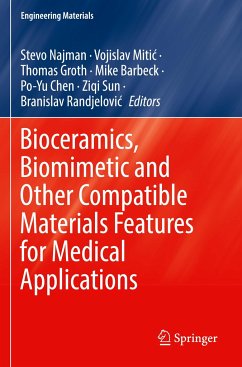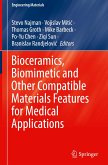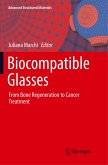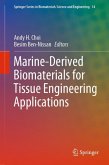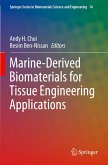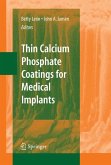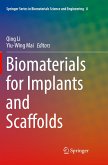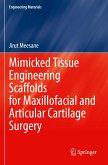Bioceramics, Biomimetic and Other Compatible Materials Features for Medical Applications
Herausgegeben:Najman, Stevo; Mitic, Vojislav; Groth, Thomas; Barbeck, Mike; Chen, Po-Yu; Sun, Ziqi; Randjelovic, Branislav
Bioceramics, Biomimetic and Other Compatible Materials Features for Medical Applications
Herausgegeben:Najman, Stevo; Mitic, Vojislav; Groth, Thomas; Barbeck, Mike; Chen, Po-Yu; Sun, Ziqi; Randjelovic, Branislav
- Broschiertes Buch
- Merkliste
- Auf die Merkliste
- Bewerten Bewerten
- Teilen
- Produkt teilen
- Produkterinnerung
- Produkterinnerung
This book reports on advanced biomaterials such as bioceramics, hydrogels, biopolymers, nanomaterials, membranes, and other compatible materials for medical applications. It introduces materials as bioactive coatings that utilize or mimic natural mechanisms and structures important for tissue and organ healing and repair. One section of the book is devoted to bone substitutes and osteogenic biomaterials. It also describes biomaterial-cell-tissue interactions, which are of critical importance for various applications in regenerative medicine, orthopedics, and implant functions. The chapters…mehr
Andere Kunden interessierten sich auch für
![Bioceramics, Biomimetic and Other Compatible Materials Features for Medical Applications Bioceramics, Biomimetic and Other Compatible Materials Features for Medical Applications]() Bioceramics, Biomimetic and Other Compatible Materials Features for Medical Applications131,99 €
Bioceramics, Biomimetic and Other Compatible Materials Features for Medical Applications131,99 €![Biocompatible Glasses Biocompatible Glasses]() Biocompatible Glasses116,99 €
Biocompatible Glasses116,99 €![Marine-Derived Biomaterials for Tissue Engineering Applications Marine-Derived Biomaterials for Tissue Engineering Applications]() Marine-Derived Biomaterials for Tissue Engineering Applications108,99 €
Marine-Derived Biomaterials for Tissue Engineering Applications108,99 €![Marine-Derived Biomaterials for Tissue Engineering Applications Marine-Derived Biomaterials for Tissue Engineering Applications]() Marine-Derived Biomaterials for Tissue Engineering Applications85,99 €
Marine-Derived Biomaterials for Tissue Engineering Applications85,99 €![Thin Calcium Phosphate Coatings for Medical Implants Thin Calcium Phosphate Coatings for Medical Implants]() Thin Calcium Phosphate Coatings for Medical Implants77,99 €
Thin Calcium Phosphate Coatings for Medical Implants77,99 €![Biomaterials for Implants and Scaffolds Biomaterials for Implants and Scaffolds]() Biomaterials for Implants and Scaffolds116,99 €
Biomaterials for Implants and Scaffolds116,99 €![Mimicked Tissue Engineering Scaffolds for Maxillofacial and Articular Cartilage Surgery Mimicked Tissue Engineering Scaffolds for Maxillofacial and Articular Cartilage Surgery]() Jirut MeesaneMimicked Tissue Engineering Scaffolds for Maxillofacial and Articular Cartilage Surgery116,99 €
Jirut MeesaneMimicked Tissue Engineering Scaffolds for Maxillofacial and Articular Cartilage Surgery116,99 €-
-
-
This book reports on advanced biomaterials such as bioceramics, hydrogels, biopolymers, nanomaterials, membranes, and other compatible materials for medical applications. It introduces materials as bioactive coatings that utilize or mimic natural mechanisms and structures important for tissue and organ healing and repair. One section of the book is devoted to bone substitutes and osteogenic biomaterials. It also describes biomaterial-cell-tissue interactions, which are of critical importance for various applications in regenerative medicine, orthopedics, and implant functions. The chapters present fabrication methods and testing of various materials for medical applications. Special emphasis is given to natural patterns, theoretical models, and new insights into material characterization, particularly on fractal natural boundaries and mimicry designs taken from nature and implemented in photonics science and engineering. This multidisciplinary book is written by leading researchers andexperts in their fields, and serves researchers, students, physicians, and engineers.
Produktdetails
- Produktdetails
- Engineering Materials
- Verlag: Springer / Springer International Publishing / Springer, Berlin
- Artikelnr. des Verlages: 978-3-031-17271-7
- 1st edition 2023
- Seitenzahl: 428
- Erscheinungstermin: 3. Januar 2024
- Englisch
- Abmessung: 235mm x 155mm x 22mm
- Gewicht: 723g
- ISBN-13: 9783031172717
- ISBN-10: 303117271X
- Artikelnr.: 69601134
- Herstellerkennzeichnung Die Herstellerinformationen sind derzeit nicht verfügbar.
- Engineering Materials
- Verlag: Springer / Springer International Publishing / Springer, Berlin
- Artikelnr. des Verlages: 978-3-031-17271-7
- 1st edition 2023
- Seitenzahl: 428
- Erscheinungstermin: 3. Januar 2024
- Englisch
- Abmessung: 235mm x 155mm x 22mm
- Gewicht: 723g
- ISBN-13: 9783031172717
- ISBN-10: 303117271X
- Artikelnr.: 69601134
- Herstellerkennzeichnung Die Herstellerinformationen sind derzeit nicht verfügbar.
Stevo Najman is a Full Professor of Biology and Genetics at the Faculty of Medicine University of Ni and he is a partially engaged professor at Faculty of Science in Ni. At the Faculty of Medicine he is Head of Department (Biology and Genetics) and Head of Scientific Research Center for Biomedicine. His research focuses on biomaterials biocompatibility, regeneration of skeletal tissues assisted by biomaterials and stem cells, tissue engineering models, as well as examination of biological activity of the substances in models in vivo and in vitro. Vojislav Mitic obtained his B.Sc. degree in 1982 in Material Science at the University of Nis; M.Sc. degree in 1990 in Material Science at the University of Belgrade and Ph.D. in Material Science at the University of Nis. He has published nearly 500 scientific publications where he pioneered application of fractal geometry and analysis in study of ceramics materials, nanotechnology, and energetic issues. Thomas Groth is Full Professor of Biomedical Materials at Martin Luther University Halle-Wittenberg. He obtained his PhD in Biophysics at Humboldt University Berlin. His research interests are focussed on modification and use of biopolymers for making cell-instructive surfaces and hydrogels for engineering of musculoskeletal tissues. He is Past President of the European Society for Artificial Organs, currently Secretary Treasurer of the International Federation for Artificial Organs and Speaker of the International PhD School AGRIPOLY at Martin Luther University Halle-Wittenberg. Mike Barbeck is Co-Founder of the company BerlinAnalytix GmbH and research group leader at the Clinic and Polyclinic for Dermatology and Venereology at the University Medical Center Rostock. He has a long experience in regenerative biomedical research working at institutes and companies in Germany. He works on the research on the principles of biomaterial-mediated tissue regeneration (mainly many different bone substitute materials and collagen materials). His research leads to further elucidation of cellular fundamentals of the foreign body response to different biomaterials. Po-Yu Chen is a Full Professor and currently the Chair of the Department of Materials Science and Engineering at National Tsing Hua University in Taiwan. His research interests include multi-scale characterization of biological materials, synthesis of bio-inspired composites and scaffolds, surface science and technologies, biomineralization, biomechanics, multi-scale modeling and A.I.-assisted approaches. He received his M.S. and Ph.D. degrees in Materials Science from University of California, San Diego, USA in 2005 and 2009, respectively. Ziqi Sun is a full Professor and the ARC Future Fellow at the Queensland University of Technology (QUT), Australia. His research interests include developing bio-inspired smart nanomaterials and 2D metal oxide nanomaterials for sustainable energy and environmental applications, such as rechargeable batteries, oil-water separations, and catalysis. Ziqi received his Ph.D. degree in Materials Science and Engineering from Institute of Metal Research, Chinese Academy of Sciences in 2009. Branislav Randjelovic is Associate Professor of Mathematics at the Faculty of Electronic Engineering Nis, working partly also as a Professor at the Faculty of Teachers Education, Leposavic, University of K. Mitrovica, where he is a Head of Department for Mathematics and Natural Science. He is also a member of various professional bodies and associations. He received his Ph.D. degree in Applied mathematics and Technical science in 2015. He works as a Head of the Institute for Education Quality and Evaluation of Republic of Serbia and his research interests are applied mathematics, discrete mathematics, algebra, graph theory, fractaltheory, neural networks, material science, as well as methods of teaching and large scale studies in education
Bone substitutes and osteogenic biomaterials.- 1. Tailoring the Microenvironment of Cells towards Osteogenic Differentiation Using Multi-layers of Glycosaminoglycans and Growth Factor Immobilization.- 2. Biology of Ceramic Bone Substitutes.- 3. Bioceramics in Orthopedic Surgery.- Materials in biomedical applications.- 4. Copper(II)-Loaded Polyphosphazenes as a Novel Detoxicant for Sarin.- Biomaterials-cells/tissues interactions.- 5. Stimuli-responsive Multilayers Based on Thiol Chemistry Controlling Adhesion and Growth of Fibroblasts.- 6. Properties of Hydroxyapatite-Based Biomaterials Important for Interactions with Cells and Tissues.- 7. Comparative in Vitro Study on Anti-inflammatory Activity of Covalent vs. Layer-by-Layer-bound Heparin and Hyaluronan Including Signal Transduction Through Transcription Factor NF- B.- 8. Biomimetics in Orthopedic Surgery and Traumatology.- Production methods and testing of materials for medical applications.- 9. Multifunctional Bio-ceramic Scaffolds and Composites Fabricated by the Freeze Casting Techniques.- 10. Preparation and Analysis Methods of Bone Ceramic Substitutes.- 11. Comparison of Numerical Model with Experimental Measurements for the Purpose of Testing Partially and Fully Biodegradable Stents.- 12. Structural nd Morphological Characterization f Strontium Ferrite-Ethylcellulose Nanocomposite for Application in Membrane Technology.- 13. Unusual Chemical Reactivity at Low Temperatures of Buckminsterfullerene C60.- 14. The Nanomaterials Fractal Characterization and Bioforensic Science.- Natural patterns, theoretical models and new insights in material characterization.- 15. Medical Devices Based on Mimicry in Light-Matter Interaction: "Structured Matter eets Structured Light".- 16. Brownian Motion Fractal Nature Frontiers within the Mater.- 17. Graph Theory Approach in Synthetized Diamonds Electrophysical Parameters Defining.- 18. Neural Networks from Biophysical Applications in Microelectronics Parameters Measurements.- Ceramics in socio-political fields.- 19. Bioceramics and Politics: (Un)likely Encounters.
Bone substitutes and osteogenic biomaterials.- 1. Tailoring the Microenvironment of Cells towards Osteogenic Differentiation Using Multi-layers of Glycosaminoglycans and Growth Factor Immobilization.- 2. Biology of Ceramic Bone Substitutes.- 3. Bioceramics in Orthopedic Surgery.- Materials in biomedical applications.- 4. Copper(II)-Loaded Polyphosphazenes as a Novel Detoxicant for Sarin.- Biomaterials-cells/tissues interactions.- 5. Stimuli-responsive Multilayers Based on Thiol Chemistry Controlling Adhesion and Growth of Fibroblasts.- 6. Properties of Hydroxyapatite-Based Biomaterials Important for Interactions with Cells and Tissues.- 7. Comparative in Vitro Study on Anti-inflammatory Activity of Covalent vs. Layer-by-Layer-bound Heparin and Hyaluronan Including Signal Transduction Through Transcription Factor NF- B.- 8. Biomimetics in Orthopedic Surgery and Traumatology.- Production methods and testing of materials for medical applications.- 9. Multifunctional Bio-ceramic Scaffolds and Composites Fabricated by the Freeze Casting Techniques.- 10. Preparation and Analysis Methods of Bone Ceramic Substitutes.- 11. Comparison of Numerical Model with Experimental Measurements for the Purpose of Testing Partially and Fully Biodegradable Stents.- 12. Structural nd Morphological Characterization f Strontium Ferrite-Ethylcellulose Nanocomposite for Application in Membrane Technology.- 13. Unusual Chemical Reactivity at Low Temperatures of Buckminsterfullerene C60.- 14. The Nanomaterials Fractal Characterization and Bioforensic Science.- Natural patterns, theoretical models and new insights in material characterization.- 15. Medical Devices Based on Mimicry in Light-Matter Interaction: "Structured Matter eets Structured Light".- 16. Brownian Motion Fractal Nature Frontiers within the Mater.- 17. Graph Theory Approach in Synthetized Diamonds Electrophysical Parameters Defining.- 18. Neural Networks from Biophysical Applications in Microelectronics Parameters Measurements.- Ceramics in socio-political fields.- 19. Bioceramics and Politics: (Un)likely Encounters.

